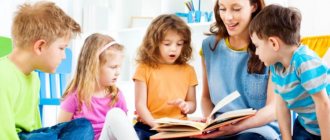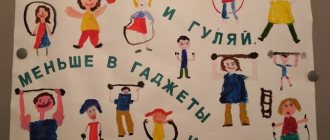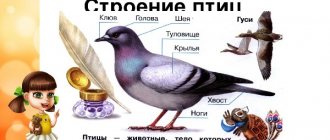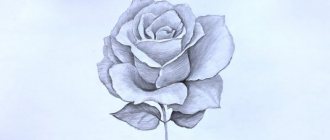Specific options for compositions (including collective ones) within the theme
Drawing for senior group students is offered in winter (December). Traditionally, this is the composition “Birds Blue and Red” (based on the poem by the Japanese poet Kitahira Hakushu “Bird, Red Bird”). The children learn to recreate a poetic image in a drawing, choosing the appropriate color palette and beautifully arranging the birds on the base.
A little later (for example, in February), the children can be offered the composition “Birds at the Feeder” (pigeons, tits, crows, sparrows). Moreover, it can be organized as a team effort. Please note that this work must be preceded by modeling.
In winter, it would also be appropriate to draw a bullfinch or a penguin.
After sculpting the rooster (in the spring), the teacher invites the children to draw this beautiful bird. The same applies to the turkey, which is designed as a decorative composition in the form of a Dymkovo toy: children draw this bird with its tail spread like a fan and paint it with characteristic patterns. At the same time, the emphasis is placed not only on object drawing, but on developing a sense of rhythm, color and composition in the design of the pattern.
Drawing birds is good to coincide with April 1, when Fr. On this day, children can depict any bird of their choice or those that preschoolers have not yet drawn (for example, an owl, a swan, a stork, etc.).
At the end of the school year, the children can be offered a creative topic - drawing a fairy-tale bird.
Note that the plots of the drawings can be associated with outdoor games on a bird theme: for example, “Day and Night” (owl), “Dog and Sparrows.” “Birds in the Nests” “Sparrows and the Cat.” These will be plot compositions.
In addition, preschoolers really love drawing based on fairy tales. In this regard, we can offer them the following topics:
- Based on the plots of Russian folk tales: “Hen Ryaba”, “Finist - a clear falcon”, “Winged, shaggy and oily”, “Cockerel and bean seed”, “Brave cockerel” (“Zayushkina’s hut”.
- “The Swan Princess” (based on the work of A.S. Pushkin “The Tale of Tsar Saltan”).
- “Rooster and Paints” (based on the work of Vladimir Suteev)
- “Cuckoo” (illustration for a Nenets folk tale, it could be a bird with a woman’s face and hair)
Older preschoolers enjoy doing work collectively. The teacher can offer them the following topics: “Poultry farm” (poultry), “Poultry canteen”, “Duck with ducklings”, “Hen with chickens”.
On the topic: methodological developments, presentations and notes
Goal: To make children want to do the work (the image of a fairy-tale bird); encourage them to create a variety of images, using different means of expression (color of plumage, different shapes of beak, tail.
Program tasks: Strengthen the skills of adding and subtracting numbers within 10. Teach children to solve arithmetic problems, put the solution on cards and pronounce notes. Strengthen comparison skills.
Summary of a drawing lesson in the senior group On the topic: “fairy-tale bird” Purpose: To teach children to conceive a fairy-tale image, come up with unusual details for a real image, develop imagination Tasks: ·.
Summary of a lesson on speech development in the senior group.
Learn to sculpt a bird from plasticine using a plastic method, pulling out parts from a whole piece and in a constructive way, observing the location and relationship of body parts, connecting parts, when.
Summary of a drawing lesson in the preparatory group “Migratory Birds”.
Topic: "Chickens". Goal: To introduce children to the technique of palm typing. Learn to add details to an image using a brush. Develop the ability to empathize. Handout
Source
Progress of the lesson:
The teacher asks the children a riddle:
When does this happen?
in spring!
That's right, as you already guessed, today we will talk about spring . People have long loved spring . People called her " spring-red "
.
Poets wrote poems about . Which of you can remember and read us poems about spring ?
(Children read poems that they had previously learned in the group of I. Pleshcheev, S. Marshak).
Look, guys, what kind of spring guests came to our kindergarten (puts three dolls on the table, decorated with: snowdrops - Vesna Martovna Podsnezhnikova, birds - Vesna Aprelevna Skvoreshnikova, cherry berries - Vesna Mayevna Chereshnikova and introduces them).
Our guests have the same first names, but different middle and last names. Why do you think they are called that? (The first name is the name of the season, the patronymic is the name of the spring month, and the last name is the name of one of the signs of this month).
In what month do snowdrops begin to bloom?
When do starlings arrive ?
Now try to remember - when will the cherry tree ripe?
Let's now take a closer look at the spring guests - Vesna Martovna Podsnezhnikova, Vesna Aprelevna Skvoreshnikova and Vesna Mayevna Chereshnikova! Have you met? That's good.
Guys, please remember what the very first month of spring is called? (Children's answers)
.
How will we know that spring has come ?
Who can name the signs of spring? The sun is high, shining brighter, the day is getting longer, drops are ringing, the snow is turning black and melting.
If all the snow melts, what will we see?
What will it be like after winter, freed from under the snow?
Black, wet. (Slide shown)
.
What do the trees look like? What can you notice?
Buds swell on tree branches, the first spring flowers appear, and the first grass emerges.
(Next slide shown)
.
What kind of first spring flowers do you children know?
Snowdrops, coltsfoot, dream grass.
(Slides with various primrose flowers are shown)
.
What birds come to us in the spring ?
Rooks, starlings, swallows, larks.
Let's draw pictures on the theme “ Spring has come . The birds have arrived "
.
We will draw with wax crayons, and at the end we will use watercolors to create the background of the drawing - this is a blue sky, and below is green grass. First, think about the plot of the drawing. What can you depict? (Trees, thawed patches and puddles on the ground, sun, birds , nests, etc.).
But before we get to work, let's prepare our fingers and do finger exercises. (Musical finger gymnastics by L. Yartov “Fingers”
).
Now let's get to work, and the music will help you feel how nature wakes up after the winter cold. Listen to how the music conveys the spring mood and try to reflect it on paper.
The children begin to work, the teacher monitors the children’s posture so that they can hold the hand correctly and freely, without tension.
At the end of the lesson , the works are exhibited at the exhibition, the children exchange impressions - which drawing they liked and why. The teacher celebrates successful work and encourages all children.
Guys, today we talked a lot about spring , looked at slides with illustrations. Each of you tried, and in your drawings it is clear that nature has awakened and come to life. And now let's say goodbye to our guests - Spring Martovna Podsnezhnikova, Spring Aprelevna Skvoreshnikova, Spring Mayevna Chereshnikova. Goodbye!
Summary of the final lesson on speech development in the middle group “Spring has come” Summary of the final lesson on speech development in the middle group “Spring has come” Zakharova V.V., teacher. Sevastopol, State Budgetary Educational Institution “Educational.
Summary of the art lesson “Spring has come, the birds have arrived”
Lyudmila Nesterova
Abstract of an art lesson “Spring has come, the birds have flown”
1. To promote the development in children of observation and aesthetic perception of the world around them.
2. To arouse the desire in children to convey on paper the characteristic features of spring (high blue sky, the ground is cleared of snow, buds are swelling on the trees, birds are flying in ), harmoniously arrange the plot on a sheet of paper, develop a sense of composition.
Slides with images of natural phenomena characteristic of spring. Slides with images of various primrose flowers.
Sheets of white thick paper, multi-colored lime crayons, watercolors, brushes, jars of water, napkins, oilcloths.
Memorizing poems about spring , reading works of natural history, observing while walking (thawed patches, puddles and streams, snow-white cumulus clouds, migratory birds , asking riddles about spring .






